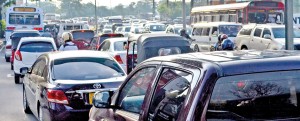News
Car entry levy planned as Colombo chokes on traffic
The Colombo Municipal Council (CMC) is considering whether to levy a fee on vehicles entering Colombo city to minimise traffic congestion.

Around half a million people enter Colombo every day and most vehicles entering the city carry only the driver
CMC Traffic Department Director Nihal Wickramaratne said a levy would push people into taking public transport instead of using private vehicles to travel to the city.
The move comes as latest statistics reveal some 100,000 vehicles enter Colombo city daily while vehicle imports have risen dramatically with an average of 1,800 vehicles imported every day.
For the first nine months of this year, 489,000 vehicles were imported.
“We will encourage people to use public transport. A special awareness programme will be implemented in this regard,” Mr. Wickramaratne said.
Given that half a million people enter Colombo every day and that most vehicles entering the city carry only the driver, officials also want to encourage vehicle owners to convey others into the city in accordance with Finance Minister Ravi Karunanayake’s Budget proposal.
Public transport needs to be improved to make train and bus travel pleasant and comfortable and persuade vehicle owners to opt for this mode of transport.

A private parking lot close to the Ragama Railway Station. Pic by Indika Handuwala
But travelling in buses, especially private buses, is not only a traumatic experience but also fraught with danger while the train service is often chaotic.
The government plans improve the “park and ride” system where parking facilities will be available close to main bus and train stations, a concept already partially popular among those travelling from outstations.
The Ministry of Megapolis is also planning to resolve traffic congestion. Consultations with IT experts, transport infrastructure and aviation authorities have begun, the Chairman of the Western Region Megapolis Planning Project (WRMPP) under the Ministry of Megapolis and Western Development, Ajita De Costa, said. He hopes to initiate public consultations soon.
“Investing in public transport, walking and cycling is the best way of taking cars off the road,” Mr. De Costa said.
The authorities have looked into crowding on the main entry points to the city including the Negombo Road via Katunayake, the Kandy Road via Kaduwela and Kiribathgoda, the low-level road from Hanwella, the Kaduwela Bridge and the High Level Road from Homagama, the Horana Road via Kesbewa and the Galle Road from Moratuwa.
Mr. De Costa said congestion was not due solely to heavy traffic volume but also to unplanned vehicle movement.
“Heavy vehicles, including container lorries, are seen on our roads during the rush hour occupying almost the entire road, their slow movement clogging up the roads, leading to traffic pile-ups one often encounters on city highways,” Mr. De Costa said.
He said the CMC should think of reintroducing a plan to restrict the entry of container trucks to the city until after 10am.
The number of vehicles in Sri Lanka would rise to 4.8 million by 2021 and 7.8m by 2031, the Head of Department of Transport and Logistics Management at the University of Moratuwa Dr. T. Sivakumar, predicts, pointing out that congestion caused traffic to travel slowly, increasing journey time and pollution.
“The economic loss due to congestion rises steeply,” he said.Dr. Sivakumar said Sri Lanka’s fuel bill was about 8 per cent of GDP, and that was likely to increase to 9 per cent.
“We have a densely populated country and need to design our transport system to suit that. We cannot design our road systems purely with expressways, elevated highways and flyovers,” he said.
Colombo authorities need to provide high-quality access to the city by public transport.
“If we promote cars and other vehicles, neglecting public transport, we will need four times more space than we have now,” Dr. Sivakumar said.
Buses need technological aids such as GPS mapping and a functioning speedometers as well as proper scheduling.
“New modes of transport should be planned. Expressways will, no doubt, help but will not solve urban transport problems, where most of the current congestion starts,” he said.

